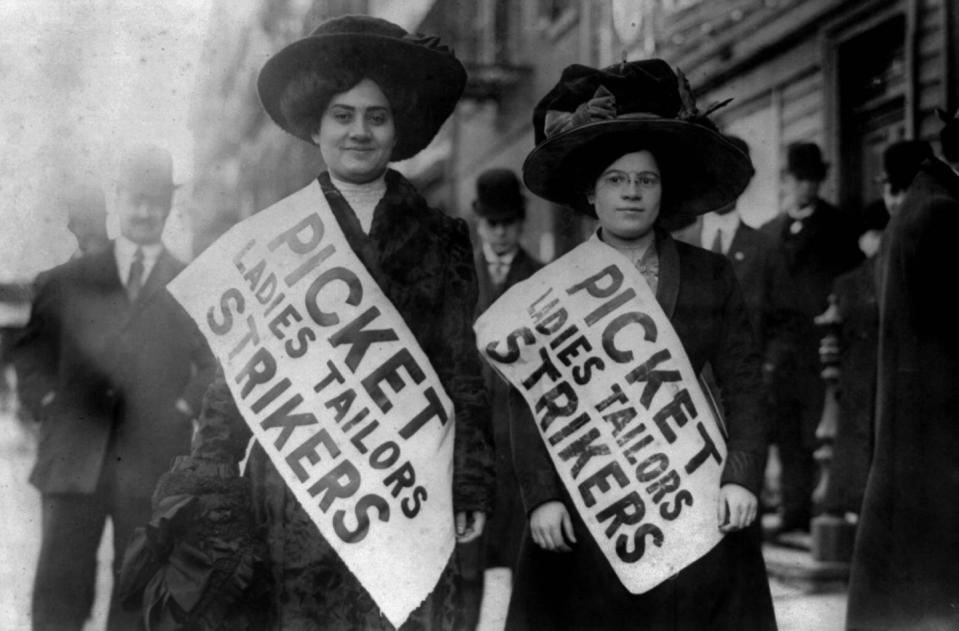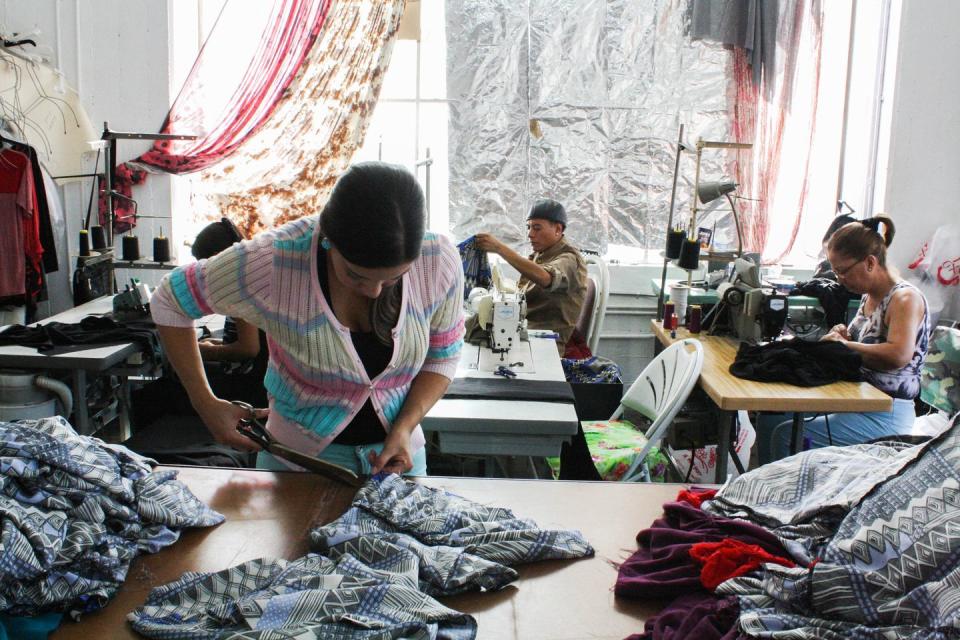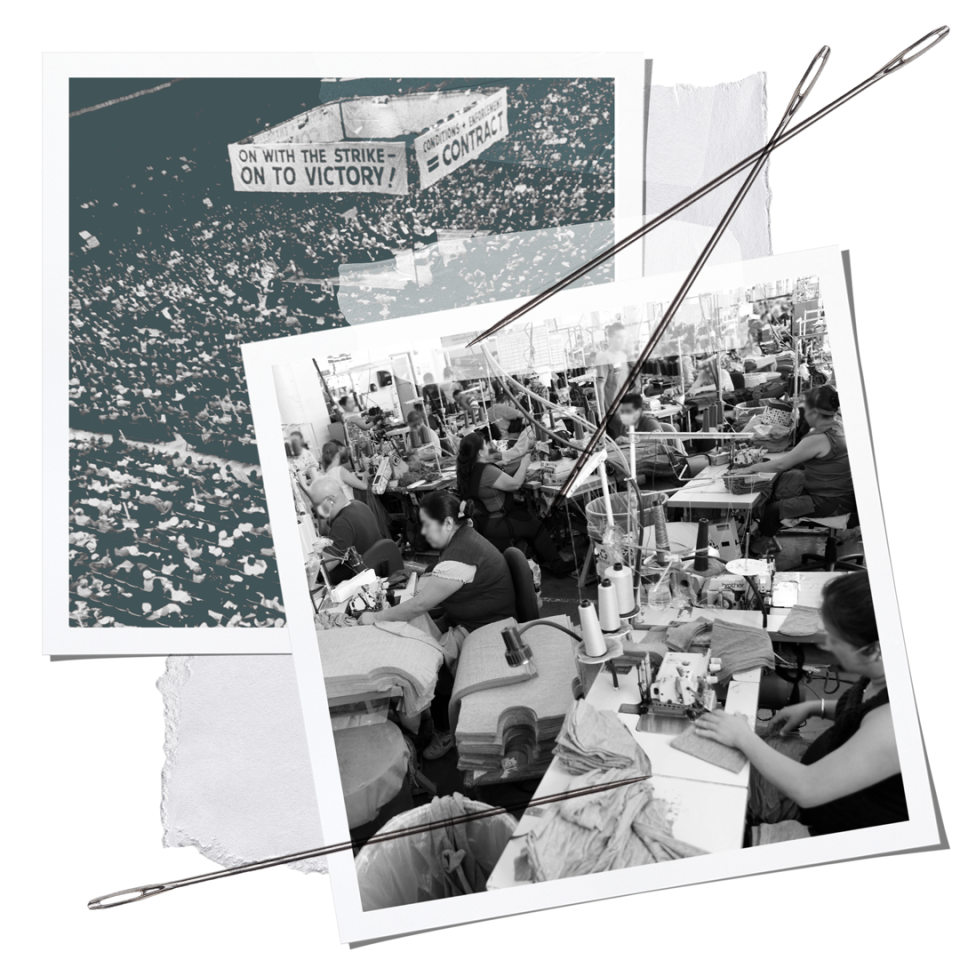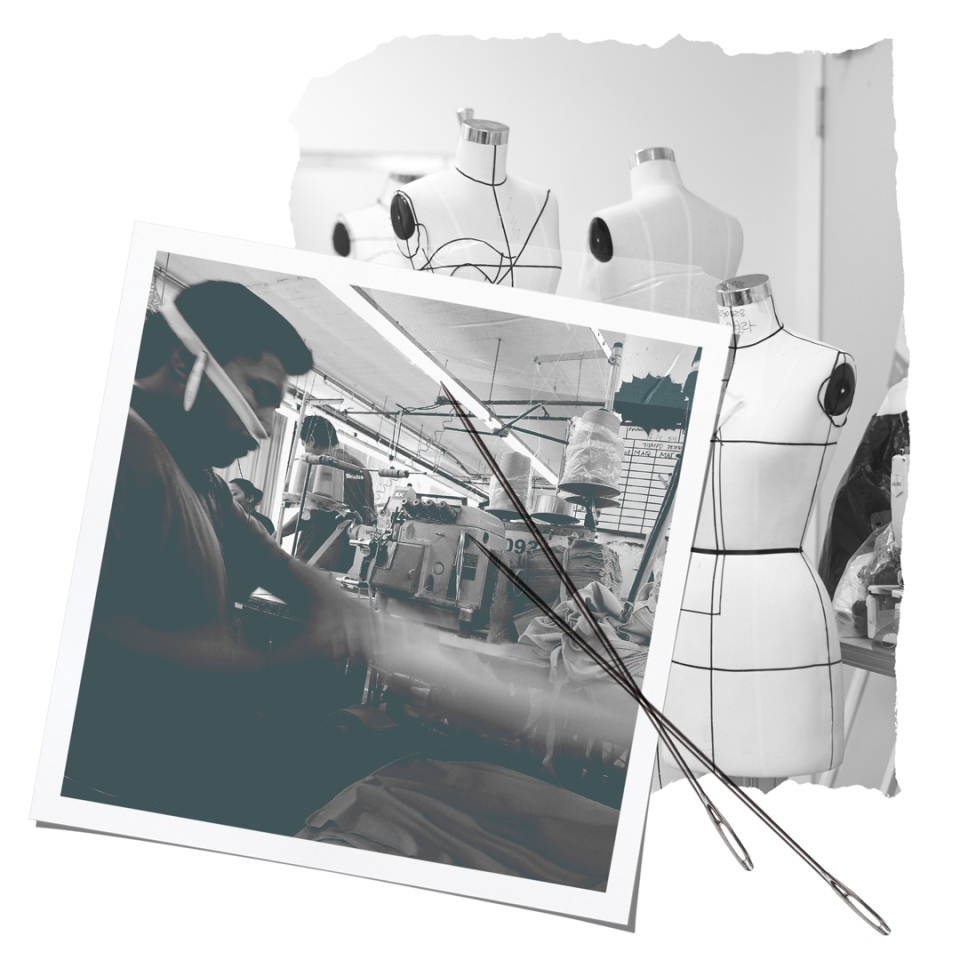A Century Later, Garment Workers Still Face the Unfair Labor Conditions That Sparked International Women’s Day

On a November evening in 1909, hundreds of shirtwaist workers, many of whom were Jewish immigrants, packed the Great Hall of New York City’s Cooper Union. Local 25 of the International Ladies Garment Workers Union had organized a meeting that night to discuss the possibility of an industry-wide strike, a practice that was still illegal at the time.
Clara Lemlich, a 23-year-old garment worker who had, at that point, already been on strike and was even briefly hospitalized after hired gangsters beat her on the picket line, addressed her fellow workers in their native Yiddish. “I have no further patience for talk,” she cried. “I move we go on a general strike!” The crowd, roaring with approval, made it official by raising their right arms together and reciting a Biblical oath: “If I turn traitor to the cause I now pledge, may this hand wither from the arm I now raise.”
The strike Lemlich rallied for, which became known as the Uprising of the 20,000, inspired Marxist revolutionary Clara Zetkin to propose the establishment of an International Women’s Day. Meant to commemorate the strike and celebrate the social and economic milestones of women, the holiday would later formally fall upon March 8, a date taken from a demonstration of female Russian textile workers who initiated the Russian Revolution.
Over a century later and 3,000 miles from Cooper Union, the site of the 1909 strike’s genesis, garment workers toil in similarly abysmal conditions in factories throughout Los Angeles’s Fashion District, mere blocks from the shining spectacles of the Staples Center and Walt Disney Concert Hall. While much of the industry’s production is now outsourced overseas to countries like Malaysia or Bangladesh, where lax labor laws allow for the further exploitation and abuse of workers, there are also about 45,000 workers laboring in these warehouses, who work for as little as three cents per piece that they assemble. Other hazards abound: Dust is thick in the air, bathrooms are left unmaintained, rats can be seen scurrying across some factory floors.
Like the striking New York garment workers from the onset of the 20th century, L.A.’s garment workforce is mostly composed of women and immigrants, though a majority now hail from Latin America and Asia. And, like the picketers, they face exploitation, threats from their employers, impossibly long workweeks, and piecework pay—even as they’re classified as essential workers by the city of Los Angeles, where they have been producing personal protective equipment (PPE) throughout the COVID-19 pandemic.
“I’ve actually never worked for a company that was clean,” says Luci Gonzalez, a 62-year-old sewing machine operator who has worked in Los Angeles’s garment industry for more than three decades since she immigrated from Guatemala. We speak over the phone through a translator. “All the factories are similar.”

At one warehouse, Luci recalls her and her coworkers needing to paper down their tables before eating because rat feces covered the surfaces. At another, a foreman attempted to swing a cane at her, which she avoided only because her husband, who worked at the same location, saw what was happening and warned her to move just in time.
The piecework pay-rate system, which bases compensation on the number of garments assembled, is a threat to workers’ livelihoods. “I’ve never had the honor to work at a place that had benefits or paid sick days,” says Luci. “It’s always been piece rate.”
Throughout her decades-long tenure as a sewing machine operator, Luci has been paid as little as three cents per assembly operation. Sometimes, she’s offered 14 cents per piece, but that’s only if she assembles the entire garment. This means that, working from 5:30 a.m. to 9 p.m. on weekdays and sometimes weekends, she makes about $380 to $410. Her husband, who works just under 80 hours a week, is paid less than that, at $220 to $275.
“We don’t have kids here, so it’s been very sad for us to survive in this country,” she says. “But we just keep moving forward and hope that God will bless us.”
Luci’s experience is far from unique. A 2016 report from the UCLA Labor Center, the Garment Worker Center, and the UCLA Labor Occupational Safety and Health found alarming statistics drawn from 300-plus surveys of garment workers in the city: 72 percent reported dust brimming their workplaces, 60 percent said that dust accumulation and excessive heat from poor ventilation made it difficult to work and even breathe, 42 percent said that their workplace’s exit doors were regularly blocked, and 42 percent had observed the presence of mice and rats at their factories. The report also noted that the U.S. Department of Labor discovered an 85 percent rate of wage and labor law violations at L.A. garment factories in 2016, the most frequent of those with violating contractors being Forever 21, Ross, and TJ Maxx.
“The idea is that you should be lucky to have a job and you do not question your labor conditions,” says Janna Shadduck-Hernández, the project director at the UCLA Labor Center and a co-author of the aforementioned report. “You do not question why your paycheck looks the way it does.”

The issue of the piece-rate pay system would have presumably been solved under Assembly Bill 633, a 1999 landmark worker protection bill passed in California. AB 633 arrived after state authorities raided an underground sweatshop in El Monte, California, where 72 Thai people were enslaved, threatened by their captors with violent harm to them or their family members, and forced to assemble garments. Among its tenets, AB 633 sought to end the plague of such sweatshop work by abolishing wage theft in the industry.
But manufacturers found loopholes.
Though AB 633 technically holds manufacturers and retailers liable for ensuring that workers are paid minimum wage and overtime, the entrance of third-party subcontractors has allowed many to circumvent the law. In one particularly damning instance, Luci recalls confronting her employer after a flea infestation at her workplace caused welts to form all over her legs. Management, furious at her complaint, attempted to make her pay for the fumigation, then fired her altogether. Soon after, Luci says, the warehouse changed ownership.
“I’ve always been willing to speak up and risk whatever came next, because I wanted to see things change,” Luci says. “I would talk to other garment workers about the issues, but I was often the only one who would speak up.”

About 71 percent of the Los Angeles' cut and sew workforce are immigrants, 87 percent of its sewing machine operators are Latino, and 60 percent in the garment sector are women, per the 2016 report. Many, too, are undocumented. At this nexus of race, gender, and legal status, some workers fear retaliation from their employers–even if the labor laws are on their side.
“There's this misconception that an undocumented worker should not be paid the minimum wage,” says Shadduck-Hernández, who notes that all of these workers, regardless of citizenship, are entitled to breaks, sick days, overtime pay, and the ability to file a wage claim at the Labor Commissioner’s Office. “Anyone who works for even an hour in this country, regardless of their status, needs to be paid the minimum wage. And if the minimum wage is not paid, that is theft. That is stealing.”
A new bill called the Garment Worker Protection Act intends to close the loopholes in AB 633. Though the bill died on the state assembly floor last September, State Senator María Elena Durazo and advocates reintroduced the act as Senate Bill 62 in December, on the first day for new bill submissions in the coming legislative session.
SB 62 expands liability to retailers, prohibits the practice of the piece-rate pay system, and authorizes the Labor Commissioner’s Bureau of Field Enforcement to investigate and cite guarantors for wage theft.
“This is a campaign that workers are really leading,” says Daisy Gonzalez, the director of organizing for the Garment Worker Center, a hub of resources for garment workers in the Los Angeles area. The center has about 360 active members, per Gonzalez, but their reach is closer to 2,000 people. “Our members make the decisions behind what campaigns we lead, what they want to see change, because they’re the ones who are directly impacted by it.”
Gonzalez felt a connection with the Garment Worker Center after watching her mother, an immigrant from Guatemala, struggle in the industry in the late ’70s and ’80s. Problems of wage theft and hazardous working environments were as ubiquitous then as they are today. “They’re the same issues she faced,” Gonzalez says, “and some of the same issues that workers faced in the early 1900s, when we saw mass movements to improve working conditions and pay in this industry.”
As its predecessor did, SB 62 is sure to face pushback from the state’s business community. Last summer, the California Chamber of Commerce rebuked the Garment Worker Protection Act, claiming that its enactment would kill jobs, impose “unfair and onerous burdens” upon employers, and destabilize an industry already suffering from the pandemic-induced financial crisis.
“Business will always try to keep as many of the profits as possible. That's why they don't want SB 62 to pass,” says Luci. “Right now, they have more power than us poor people do.”
Luci and her husband stopped working last March, when the state government had just begun to urge people to wear masks and stay home to curb the spread of COVID-19. At the time, she had asked her manager if they were planning on spacing the sewing machine stations six feet apart, as recommended by the Centers for Disease Control and Prevention. He said no.
“As older people, this invisible virus is very dangerous for us,” she says. “I was only making $220 to $250 a week there, which is too little to risk my own health.” Since, she and her husband get meals from a local school and have sought financial support from the Garment Worker Center, which has been distributing thousands of dollars in funds to workers throughout the pandemic. Meanwhile, the conditions of her former workplace have remained just as cramped and dirty even as it shifted to producing PPE and hospital robes, according to a friend of Luci’s who continued to work there after she left. At the entrance of the South Central warehouse now, a table provides disinfectant and face masks—but not for workers. Instead, the protective gear is intended for managers and the employer.
Last June, the city’s Department of Public Health forced Los Angeles Apparel operations to shut down after inspectors discovered “flagrant violations” of public health and infection control guidelines, including cardboard barriers set up between workers and a lack of social distancing, the Los Angeles Times reported. Of the 400 employees who were producing 100,000 masks per week for Los Angeles Apparel, whose website includes a page dedicated to their efforts in sustainability and worker rights, there were four virus-related deaths and 300 infections.
“The issues that garment workers face don't come from just one or two bad actors,” says Gonzalez. “It's really embedded in the industry.”
Though garment workers have for years advocated for themselves at their workplaces, union rates are on the decline. “This was one of the major industries that had a labor union for years,” says Shadduck-Hernández. “This has become more and more of an anti-collective bargaining and anti-worker society.”

The International Ladies Garment Worker Union, at its peak, was one of the largest labor unions in the U.S., and one of the first to organize women at a time when their work was deemed “unskilled labor.” In 1909, the striking shirtwaist workers put the right to unionize at the forefront of their demands. This ability to unionize, along with the solidarity exhibited by thousands of women at the picket lines, also animated those early proponents of International Women’s Day.
“International Women's Day comes out of the socialist parties of Europe and the desire of American socialist men and women, but particularly women, to make the argument that suffrage, the vote, was not enough,” says Alice Kessler-Harris, a professor emerita at Columbia University and one of the leading labor historians on women and gender. “That, as far as working people were concerned, working women would need not just the vote, but also all kinds of regulations and trade unions to protect them.”

Though the 1909 shirtwaist makers' strike marked a pivotal moment for women to be taken seriously within the American labor movement, it wasn’t entirely a success. The strike ended in February, after three months of standing in a wintry picket line and facing off cops, who beat the women or even had them thrown into cells at Blackwell’s Island. In the end, many of the larger manufacturers refused to sign contracts recognizing the union. It wasn’t until two years after the strike, after a fire at the Triangle Shirtwaist Factory killed 146 people and images of women jumping from the building galvanized lawmakers, that New York enacted its first major worker protection laws, including legislation for fire prevention and compulsory factory inspections.
“Those women, though they went back to work without a contract, nevertheless remained supporters of the union and, I would say, of socialism more generally,” says Kessler-Harris. “It was socialism that was the moving spirit of the ILGWU in those early days.”
After almost 100 years of activity, the ILGWU dissolved in 1995 following declining membership and internal struggles. The union merged with the Amalgamated Clothing and Textile Workers Union, then, later, the Hotel Employees and Restaurant Employees, forming UNITE HERE.
Despite the fading state of garment worker unionization today, Gonzalez believes the Garment Worker Center would be on board should L.A. workers decide to follow in the 1909 strikers’ footsteps. “Whatever tactics are necessary, I think we have to put them on the table,” she says. “Workers, I think, are fed up and they want to see a change in an industry that they really love.”
While much of the industry seems to be repeating mistakes of the past, there are some signs of change. Organizations like Remake are carving out space in the digital media landscape to contend with fashion’s worker rights issue, and brands like Mara Hoffman have reorganized their supply chain to prioritize worker dignity.
“You cannot be a ‘sustainable’ brand if you do not advocate for the humans behind it,” says Dana Davis, Mara Hoffman’s vice president of sustainability, product, and business strategy, “which is why this became the next focus point for us.”
The womenswear label shifted its manufacturing process in 2015, offering an early blueprint for other brands looking for a new kind of business model that emphasizes working conditions, sustainability, and transparency. Mara Hoffman achieves this through conducting regular in-person factory visits and working to provide fair wages. Under COVID, Davis says, the company works closely with manufacturers that have social compliance certifications in order to ensure safe conditions for their garment workers.
“Six years ago was a different world in sustainability. It was challenging to convince the wholesalers that had been buying from us for years to join this movement,” says Davis. “We understood then that accounts and customers were going to leave us, but ultimately we felt it was our responsibility to make this shift.”
When she returns to work, Luci wants to see the advent of strong labor laws, the end of piece-rate pay, clean factories, and paid breaks. But, though support for SB 62 and garment workers at large is growing, one particular experience at a former workplace makes her wonder if change will ever come.
In 2008, after asking for a two-cent raise, her employer fired her on the spot. “Get out of here, you Mexican immigrant,” the management had yelled at her then, Luci recalls. The lack of protections against her sudden expulsion and the dehumanization in the racist epithets lobbed against her marred her experience in garment work forever after.
“I’m not Mexican and I’m not undocumented,” says Luci. “Thank God I’ve been blessed with citizenship. But, in every factory that I’m at, I always ask myself, ‘Will this happen to me again?’”
You Might Also Like

